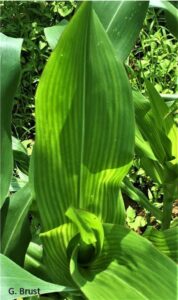Plant-available sulfur (sulfate) values have been added to Rutgers Soil Testing Laboratory fertility reports in the micronutrient reporting line. There are four interpretive categories: Low, Medium-low, Sufficient, and High. An explanatory paragraph follows near the end of the report to help interpret the reported value.

Symptoms of sulfur deficiency include yellowing or light green coloring on youngest tissue, thin stems and petioles, slow growth, and delayed maturity. Photo Credit: G. Brust, University of Maryland.
As the interpretative statements within the reports explain, sulfur analysis/interpretation is very complicated (similar to nitrogen) due to the many factors influencing it. Also, there is not full consensus among soil fertility experts on a best extraction method and critical values. Still, the sulfur value on the revised reports will provide an extra degree of information for understanding the soil & plant health. As with all micronutrient interpretations on the reports, the relevant RCE publication is referenced for further information; in the case of sulfur, RCE bulletin E365.
With respect to plant nutrition, sulfur deficiencies were once considered rare, due in part to atmospheric deposition from sulfur dioxide emissions (pollution) from burning of coal. Since implementation of the Clean Air Act (esp. CCA of 1990), atmospheric deposition no longer supplies as much sulfur to soil, and sulfur deficiencies have become more common for certain crops in certain regions under certain management situations. The crops that need/extract more sulfur from soil and therefore are more susceptible to deficiency include agronomic crops, legumes, and vegetables in the Brassica/Cruciferae family or Allium (onion) genus.
The natural, major source of plant-available soil sulfur (sulfate ion) is organic matter decomposition. Sulfate is water-soluble and so susceptible to leaching, and so sandy, low organic matter-soils are most prone to sulfur deficiency. Deficiencies may be time- and weather-dependent, such as in spring when cold soil limits organic matter decomposition and leaching from frequent rainfall is most likely. However, established, deep-rooted vegetation may have access to sulfur in subsoil, so sampling soil at greater depths is suggested for better assessment of sulfur availability.
For long-term sulfur fertility, incorporate best management practices to build or maintain organic matter content in soil.

